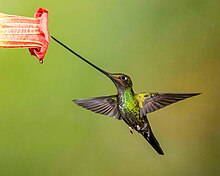Sword-billed hummingbird
| Sword-billed hummingbird | |
|---|---|

| |
| Male | |

| |
| Female sword-billed hummingbird (right) with a buff-tailed coronet
| |
| Scientific classification | |
| Domain: | Eukaryota |
| Kingdom: | Animalia |
| Phylum: | Chordata |
| Class: | Aves |
| Clade: | Strisores |
| Order: | Apodiformes |
| Family: | Trochilidae |
| Tribe: | Heliantheini |
| Genus: | Ensifera Lesson , 1843
|
| Species: | E. ensifera
|
| Binomial name | |
| Ensifera ensifera (Boissonneau, 1840)
| |

| |
| Distribution range of the sword-billed hummingbird | |
| Synonyms | |
|
Ornismya ensifera Boissonneau, 1840 | |
The sword-billed hummingbird (Ensifera ensifera), also known as the swordbill, is a
The sword-billed hummingbird is a
Taxonomy and systematics
The sword-billed hummingbird was first
The sword-billed hummingbird is the
Description
The sword-billed hummingbird is among the largest species of hummingbirds. Adults are 13–14 centimetres (5.1–5.5 in) long excluding the bill and weigh 10–15 g (0.35–0.53 oz), with males being slightly larger on average than females.[11] The most distinctive feature of the species is the enormous bill, which is 8–12 centimetres (3.1–4.7 in) long.[12] The bill is the largest of any hummingbird and the largest with respect to body length for any bird.[10]
The sword-billed hummingbird displays
The sword-billed hummingbird is the only known bird whose bill is longer than the rest of the body, excluding the tail.
Vocalizations
The sword-billed hummingbird makes a low, guttural, slightly trilled trrr.[10][11]
Habitat and distribution
The sword-billed hummingbird is found in the
The sword-billed hummingbird's distribution correlates with the distribution of species of the subgenus Tacsonia in the genus Passiflora, due to its highly specialized bill and feeding habits.[12][15]
Behavior and ecology
As is characteristic of hummingbirds, the sword-billed hummingbird can fly backwards and hover in the air.[16] It also exhibits higher than average wing-disk loading than other members of its family.[17]

Diet and feeding
The sword-billed hummingbird is a
Perching and preening
The sword-billed hummingbird perches with its bill angled upwards to reduce the strain of the heavy beak and improve balance.
Reproduction
Breeding occurs from February to March. Nests are
Co-evolution with Passiflora mixta

The sword-billed hummingbird displays extreme
Status and conservation
The sword-billed hummingbird is listed as being of least concern by the International Union for Conservation of Nature (IUCN) on the IUCN Red List due to its large range, lack of significant population decline, and lack of major threats. There is also no census on global number of individuals, because of the large range of occurrence and uncommon sightings.[14] It has adapted to man-made habitats in some areas and is also known to occur in several protected areas.[10] Climate change and deforestation are the two most probable threats to the sword-billed hummingbird as they may lead to habitat loss and a decrease in food sources, especially of Passiflora mixta.[19]
In art and media

The BBC's documentary series Planet Earth II depicted the sword-billed hummingbird flying through the forest in the episode Jungles.[13]
References
- . Retrieved 12 November 2021.
- ^ "Appendices | CITES". cites.org. Retrieved 2022-01-14.
- ^ Société Cuvierienne; Cuvierienne, Société (1839). Revue zoologique. Vol. 2. Paris: Société cuvierienne.
- ^ Cottrell, G. William; Greenway, James C.; Mayr, Ernst; Paynter, Raymond A.; Peters, James Lee; Traylor, Melvin A.; University, Harvard (1945). Check-list of birds of the world. Vol. 5. Cambridge: Harvard University Press.
- ISBN 978-1-4081-3326-2.
- ^ "Hummingbirds – IOC World Bird List". Retrieved 2021-10-09.
- ^ "Ensifera ensifera (Sword-billed Hummingbird) - Avibase". avibase.bsc-eoc.org. Retrieved 2021-10-09.
- ^ "Definition of SWORDBILL". www.merriam-webster.com. Retrieved 2021-10-09.
- .
- ^ S2CID 241590785, retrieved 2021-10-09
- ^ OCLC 11234472.
- ^ PMID 30586466.
- ^ a b "Sword-billed hummingbirds are the only birds in the world to have beaks longer than their bodies. - In pictures... Jungles". Planet Earth II. BBC One. Retrieved 2017-10-15.
- ^ .
- ^ S2CID 85573624.
- PMID 23014570.
- ^ Snow, David (1980). Relationships between hummingbirds and flowers in the Andes of Colombia. British Museum: Bulletin of the British Museum.
- S2CID 53184717.
- ^ PMID 25274372.
External links
- Video of female using feet for grooming, Internet Bird Collection website
- Vocalizations
- Skeletal structure photo and description

